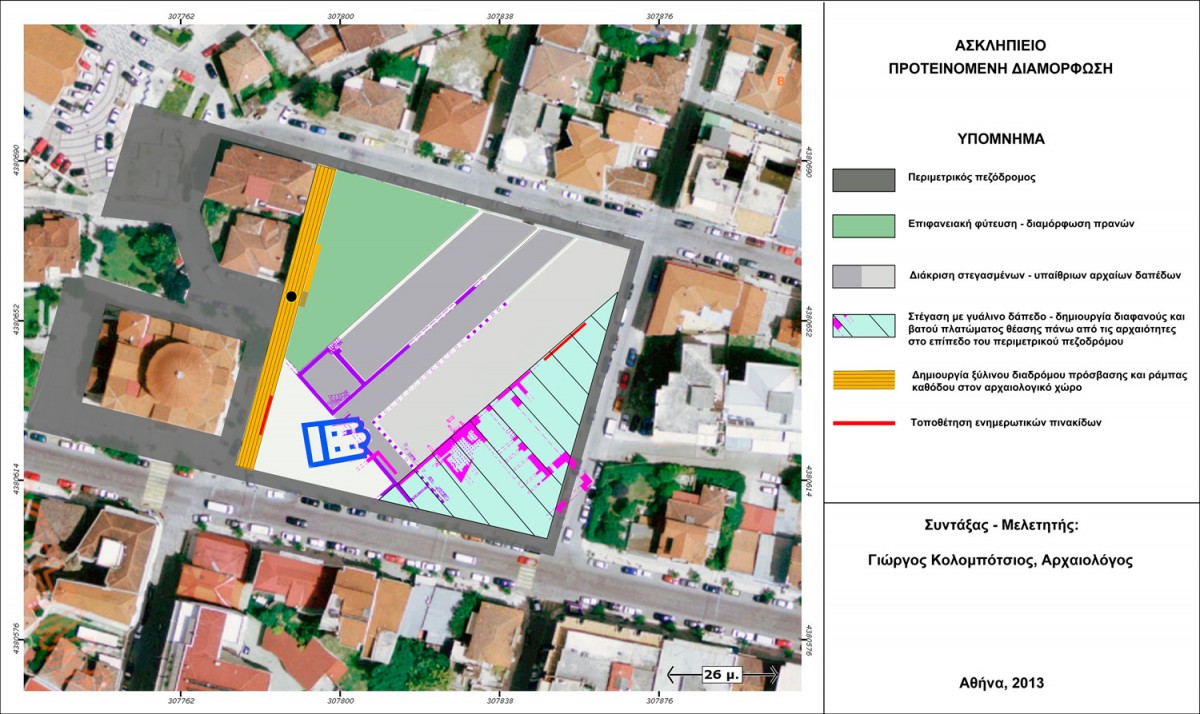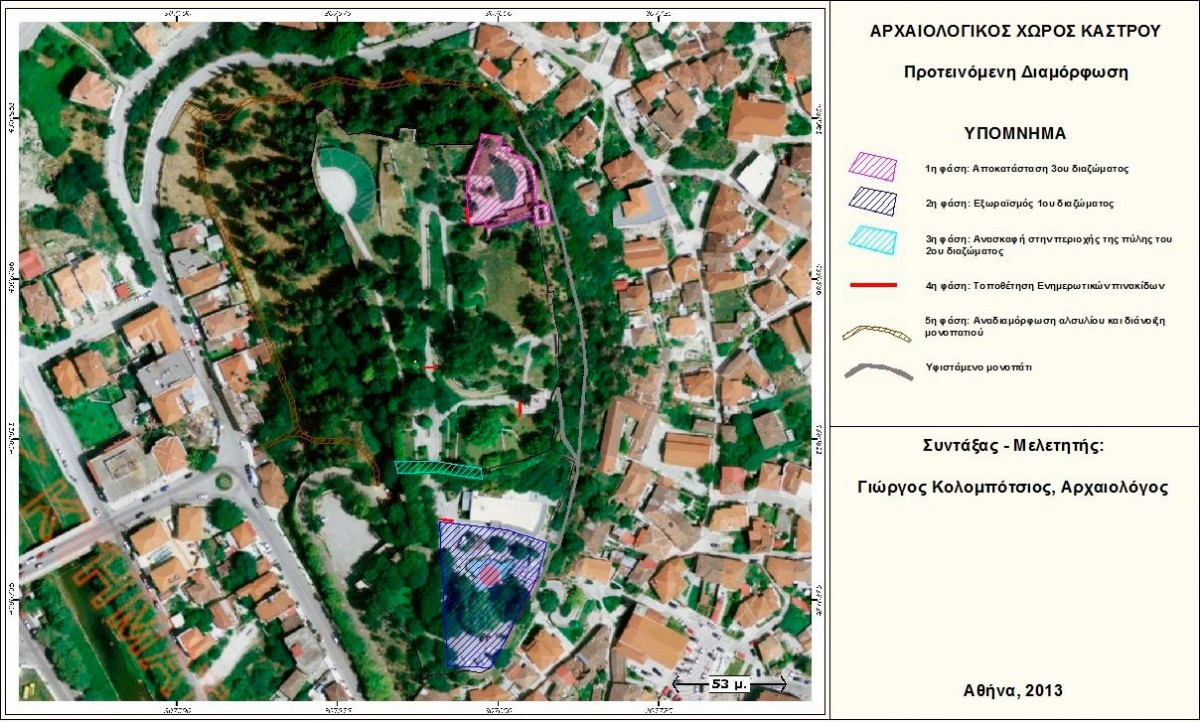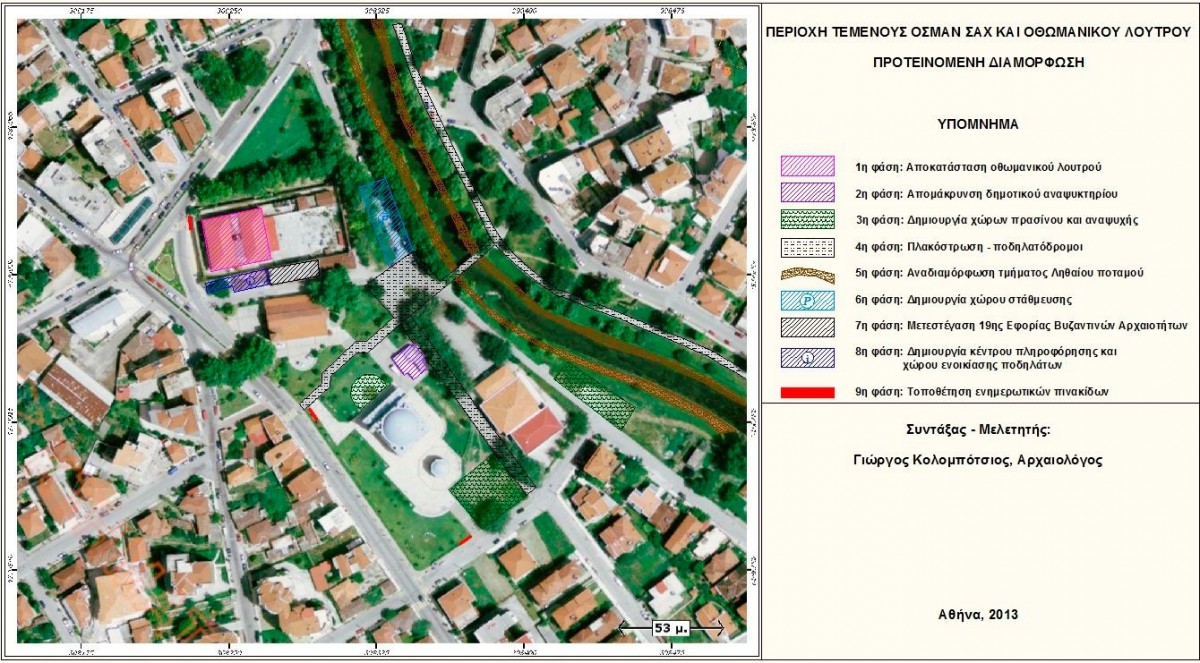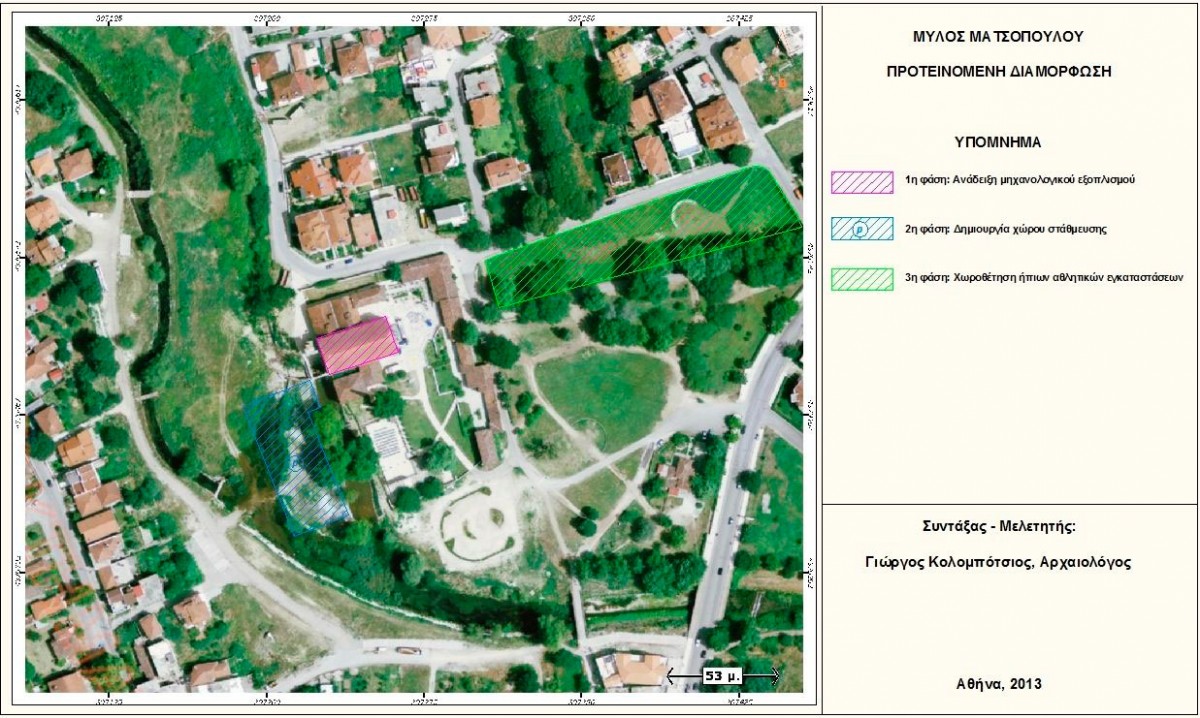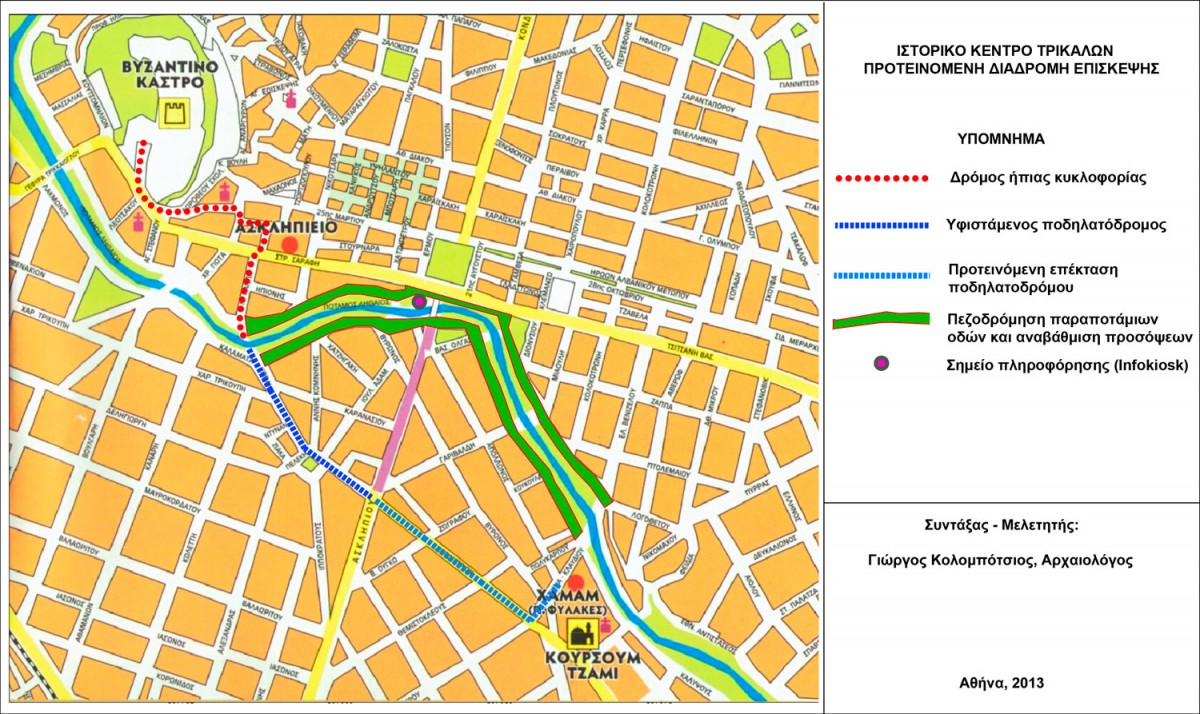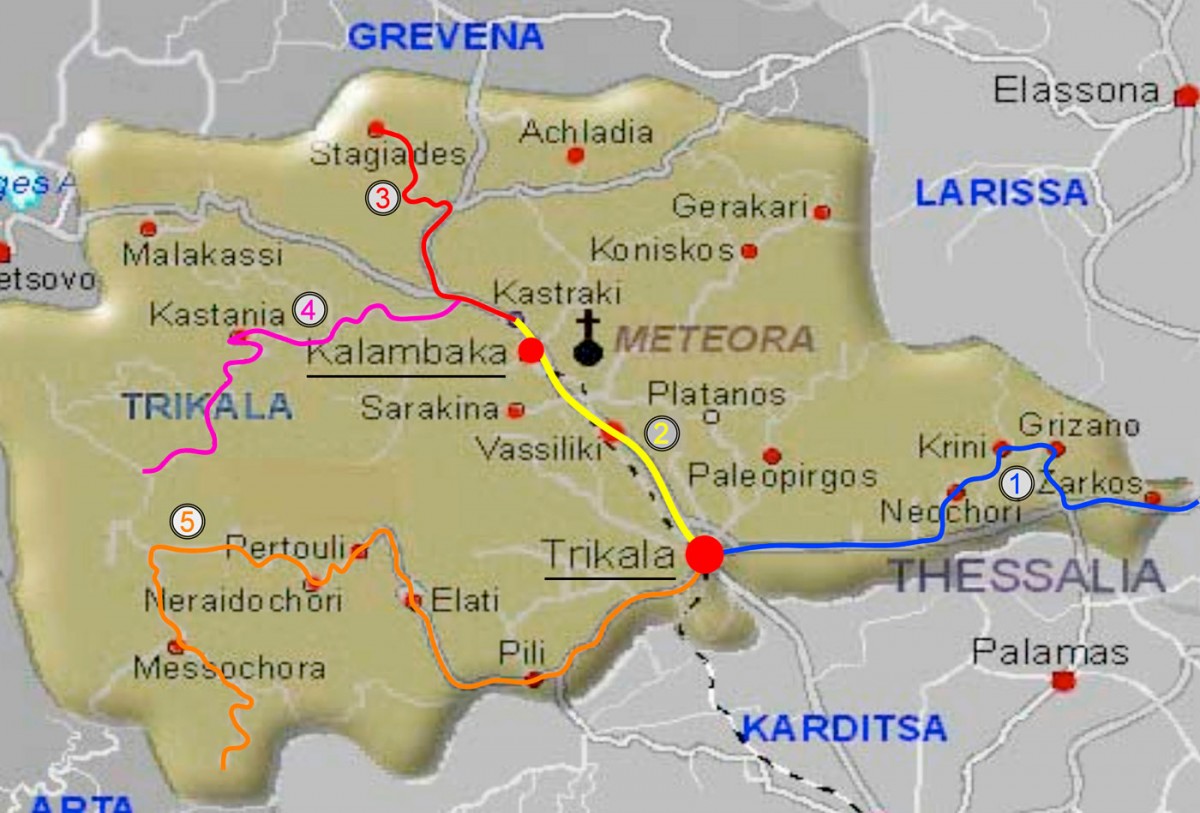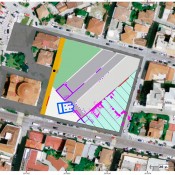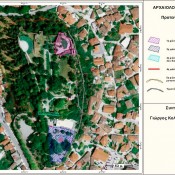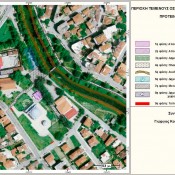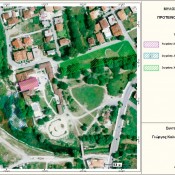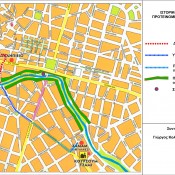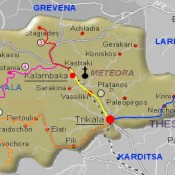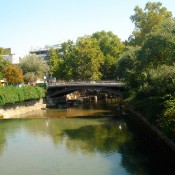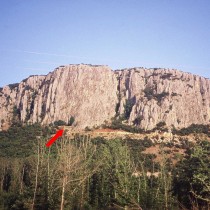Management of the archaeological work
The operations already carried out on the monuments or scheduled to be realized in the near future and referred to further on, are related to the protection and enhancement of the monument sites in Trikala. Some additional proposals to be made in this paper aim at creating an organized network of visitable archaeological sites and monuments. Moreover, these monuments’ rational management and promotion are dictated by a series of specific values they embody:
Scientific value: These are monuments and groups of monuments with special scientific value since they are a very important source of knowledge in the study of the evolution both of town planning and monument architecture.
Historical value: The monuments are associated with historical events (e.g. Justinian’s construction programme) and they mark the town’s evolution through time. They are a source of information for all phases in the town’s history both ancient and modern.
Unique value: The Osman Shah Mosque is the only piece of architecture on Greek soil designed by the important 16th century architect Sinan. There is also the excellently preserved wooden supporting structure of the interior of the Matsopoulos Mill’s main building which is one of the very few examples of its kind surviving in Greece today.
Local value: The sites mentioned above are important components of Trikala’s past linked to the collective memory of its population. Particularly the Castle and the Mosque were always visible inside the town because of their size and position. Their further enhancement could allow them to be included in a broader network of visited monuments in the Π.Ε. (Regional Unit) of Trikala.
Cultural value: The sites can attract visitors by combining recreation with acquiring a knowledge of history. The connection of the monuments to the written sources offers a unique opportunity for reading the past. At the same time, the uses they have been given and the infrastructure in some of them (the Castle’s tourist pavilion and open air theatre, the organizing of temporary exhibitions in the Mosque) make them approachable and familiar to people as they combine education with leisure.
Economic-tourist value: The enhancement and promotion of the above sites combined with the existing infrastructures and the rest of the monuments and sites of the area around the town can play a part in attracting additional visitors.
Proposals
A) Operations on the monuments and the area surrounding them.
1. The archaeological site of ancient Trikke: As mentioned before, the remains in the archaeological site of ancient Trikke have not been completely uncovered since the rest of them are located under the existing buildings and the main roads. In addition, converting these sites into public areas that can be functioning extensions of the town presents an architectural issue today, involving many complex problems in its solution.
The following actions and reversible operations are proposed (fig. 1) in a first attempt at enhancing the site and taking into consideration the data till now:
-The expropriation of the properties in the N, E, and S corner of the site and an excavation survey after the buildings there have been demolished. If the project of the site’s enhancement is included in a programme of community funding, provision will be taken for a percentage of the credit to go towards the expropriations. Alternatively the possibility could be explored of the relevant Municipality exchanging all or at least some of the said properties with ones of corresponding value owned by it. This would free the space and avoid complaints from the alleged owners.
– Cleaning, the removal of soil (with the excavation method) and the clearing of trees in the Arcade, the Hellenistic building and the basilica.
– Strengthening and maintenance, where required, of sections of the masonry.
-Removal of the existing protective shelter over the Roman bath and its replacement by a new transparent (glass) plateau to be walked on, so as to view the monument’s ground plan from above. It goes without saying that for this proposal to be realized, it has to be preceded by the existing building’s expropriation and demolition.
– Replacement of the mosaic floors or their copies in their original position.
– Covering of the areas taken up by the monuments with an asphalt membrane and inert materials (white gravel) so as to limit the growth of grass and to clarify the outlines of the monuments’ ground plans.
– Cordoning off of the monuments and creating a walk for visitors in the archaeological site.
– Placing information boards for visitors.
– Removal of the existing fence.
– Creation of a wooden stepped plateau and steps for descending along the area’s north side.
– Abolition of the road between the cathedral and the archaeological site and its unification with the existing landscaped areas surrounding the churches of St Nicholas and St Episkepsis for them to become a single public space together with the enhanced archaeological site.
-Lighting of the archaeological site for it to be seen better and be protected from possible vandalism during the night.
Since no initiative has been taken so far by the Archaeological Ephorate for the conducting of a study for the enhancement of the site in question and because the current economic climate does not allow this study to be taken up by a specializing office, it is proposed to look into the possibility of it being carried out by a team of specialist employees from both the Ephorate and the technical services of the Trikke Municipality. Then after it has been properly approved it can be implemented through the next EU funding programme (NSRF) or by a contract with the Region of Thessaly which will undertake its funding by its own means. It should be noted that according to preliminary figures released for the upcoming NSRF, part of the funding is intended to realize “urban upgrading”. I believe that the proposed works for the improvement of the region of ancient Trikke are in the spirit of the programme in question.
2. The Castle and Varousi: The monument’s basic problems are to be located on its third level which has not been dealt with more systematically than once in the past (1980-1981) when some small scale works of support were done to parts of it.
It can be restored by dealing with structural problems while its upgrading can be achieved by getting rid of subsequent unsuccessful interventions to be followed by landscaping the surrounding area. A prerequisite for success is keeping to the general principles, mentioned above, of monument conservation and restoration.
More specifically, operations should be carried out in the following areas (fig. 2):
The third level
a) Restoration of the masonry: the removal of damaged sections of stonework and their reconstruction with new materials (lithosyrrafe method), followed by jointing and cement grouting so as to stabilize the existing stones and to prevent moisture from seeping into the wall’s core.
b) Restoration of the towers: The SE tower is the only one whose remains are higher than the ramparts and structurally is in a good condition but in urgent need of jointing mainly of the exterior facades.
The N tower requires the pointing and preservation of the remaining ramparts, the clearing of vegetation and the sealing of the tower’s top surface with cement with a good waterproofing grade factor.
The other two towers (T3 and T4) should be cleared of vegetation and debris and then be rebuilt up to the ramparts.
In addition, all the towers should be roofed and their door and window frames replaced.
c) The arsenal: It is relatively well preserved, however work is required to restore both the masonry and the dome structure, as well as waterproofing and replacement of door and window frames.
d) Work on the interior: The removal of the modern tiled porch is required as well as the levelling and upgrading of sections of the paving so as to create walks for visitors.
The first and second level
a) Excavation survey: An excavation survey is proposed in the area of the entrance gate on the second level where in Byzantine times, according to tradition, the church of the Taxiarches was situated, the remains of which have not been located so far.
b) Restoration on an aesthetic level: Removal of recent, mainly wooden, auxiliary buildings of the Tourist Pavilion, the exclusion of vehicles and a partial redesigning of the existing refurbishments such as paving, fountains et al in the first level area.
Other modifications
a) Notice boards: Notice boards should be placed in key points of the Castle, contributing to the visitors’ better understanding of the site and its history.
b) Interventions outside the walls: For the further protection and enhancement of the monument the following interventions are considered necessary in the surrounding area which, for most of its perimeter, is a forest. Till now, no particular programme has been implemented to deal with the vegetation that has got out of hand, hiding the view of the castle and endangering the monument itself as well as the vicinity.
– Tackling the existing vegetation by removing dry, mostly coniferous trees, including those that, due to their proximity, damage the castle walls.
– The planting, where necessary, of preferably deciduous trees growing locally, to reduce the chances of fire.
– Widening the existing trail and refurbishing it by pruning, clearing of trees etc. Then it is proposed that it be further extended from the W to the N side of the monument to create a visitors’ trek.
– Designing resting spots and observatories by placing seats, waste bins et al.
For the trail’s refurbishment packed soil is suggested which can be boxed in wooden planks. In addition, all the proposed visitors resting spots can be refurbished with wooden equipment (note 1).
Finally, the unsightly sign post placed at the entrance of the Varousi district, on the castle’s SW side should be replaced immediately.
Lighting
It is considered necessary, after a relevant survey, to install electromechanical facilities for the Castle to be lit and become more visible at night.
The statutory use of land and building regulations in the region including Ancient Trikke, the Castle and Varousi.
For the protection of the site of Ancient Trikke, the Castle and the traditional district of Varousi, it was found necessary to update their status as listed buildings by integrating these monuments in a single archaeological site. Following no. 10/10-4-2012 Recommendation from the Central Archaeological Council, a decree from the Ministry ΥΠΠΟΤ/ΓΔΑΠΚ/ΑΡΧ/Α1/Φ43//51102/2544 was issued in the Government Gazette 208/ΑΑΠ/14-6-2012. According to this, the boundaries of the unified archaeological site coincide with the axes of the following existing municipal streets: to the east with Clemenceau str., Chairopoulos str., Chr. Karras str, Persephone str. and Macedonia str. to its junction with Plataion str. To the northeast with Plataion str. and N. Plasteras str. to the junction with the Ioannina-Trikkala highway .To the west with Myrofyllou str., Chateaubriand str. (along the Lethaios river) to the junction with Clemenceau str.
This way, activities in the region will be better controlled, since excavations will be regulated by the 34th Ephorate of Prehistoric and Classical Antiquities and construction activities by the 19th Ephorate of Byzantine Antiquities and the Service for Modern Monuments and Technical Projects of Thessaly.
For a more rational management of the unified archaeological site a presidential decree is required for land use and building regulations, according to articles 13 and 14 of Law 3028/2002, so as to update the one applying to Varousi.
3. The Mosque and the Ottoman Baths: As mentioned before, the Osman Shah Mosque has already been restored and does not need further work done on it. Of course graffiti needs to be erased from its masonry using special cleaning liquids, a job that can be done by the existing staff of the 19th Ephorate of Byzantine Antiquities.
Regarding the adjacent Ottoman Baths and the imminent conversion of its first floor into a Research Centre /Museum of Vassilis Tsitsanis, the 19th Ephorate of Byzantine Antiquities which is in charge, is working on a project for the Bath’s restoration and enhancement. All proper actions have been taken for its realization, as well as spoken agreements for it to be included in the funding programme.
The following work is required on the site:
– An excavation survey for the complete uncovering of possible archaeological remains, original floors etc.
– The demolishing of all later additions to the building, layers of paint etc.
– Tackling structural problems.
– Restoration of the site’s original appearance, based on the data to be discovered.
-The monument’s aesthetic upgrading.
– The site’s functional use, following its design, as a permanent exhibition space for the Archaeological Collection of Trikala.
At the same time it is proposed that the 19th Ephorate of Byzantine Antiquities be relocated to the administration building of the former prison which has no particular use. In this way, the Ephorate’s operating costs will be reduced and the region will also be better supervised since the staff will be present on a daily basis.
Furthermore, it is thought necessary to carry out moderate alterations in the wider surrounding area so as to change this region into a cultural reference point for the town (note 2).This is in the context of realizing the studies for reuse of the two storey main building of the Prison and the restoration-enhancement of the bathing complex of Osman Shah.
More specifically, the following modifications are proposed (fig. 3 – a general plan of modifications):
– Removal of the playground from the SE side of the Osman Shah mausoleum and its installation in an area to the NE of the Primary School.
– Collection and arrangement of scattered architectural ruins located round the Mosque.
– Removal of the present fountain on the W side of the Mosque and the filling in of the void with earth so as to be incorporated in the existing greenery.
– Removal of the Municipal Cafeteria on the N side of the Mosque and provision for creating a new one on the site of the former Prison.
– Landscaping of the river banks and the creation of walks and resting spots (the modified riverbanks end 50 m behind, almost next to the N corner of the Prison wall).
– Layout of cycling and pedestrian paths on both banks of the river Lethaios.
– The cemented sections between the Primary School and the Mosque and between the church of St Constantine and the Prison should both be paved and joined to the already modified sections. In addition, the section between the Primary School and the Mosque should be planted with tall trees to hide the School as much as possible.
– Demolition of the former Prison wall for the enhancement of the site and a view of the Baths. A small section of the wall could be kept just as a reminder of the site’s previous use, while the rest of it could be marked on the ground by different coloured paving. Alternatively the wall could be kept lower.
– Blocking of the access of vehicles to the area between the Prison and the river. This move should be combined with creating a small parking space in the district NE of the Prison.
– Installation of ground lighting, following an appropriate study, in selected spots of the monuments’ surroundings for their visibility at night and their protection from vandals.
– Installation of information boards for the public outside the Mosque and the Mausoleum.
4. The Matsopoulos Mill: As mentioned above, work will soon start on the restoration and enhancement of the mechanical equipment of the Mill’s main building. This project is part of the more general development of the complex and its surroundings for it to become a cultural focus point for visitors. It includes making a museum of the Mill’s buildings, its industrial equipment which is perfectly preserved in situ and the early 20th century process of handling grain.
Regardless of the above, the area’s main disadvantage is the absence of a specifically designed parking space which is absolutely essential for the Mill complex in particular. This applies especially during the Christmas period because of the “Elves in the Mill” event which brings in visitors from all over Greece, creating traffic jams in the area.
It is proposed to convert to a parking space an untouched area situated to the west between the complex and the Agiomoniotis river. Modifications should be made with materials compatible to the region’s overall physiognomy. Compressed red soil is therefore recommended for covering the ground surface and the use of low wooden elements for the space’s enclosure (fig. 4 – the general plan for modifications).
As the monument has been used in many ways and stays open till late at night, no extra lighting is considered necessary.
B) More general interventions
1. The creation of an Information Centre: In a part of the former Prison building, it is proposed to plan for an Visitors’ Information Centre. Printed information material such as guides and pamphlets will be available while internet should be installed where the sights will be shown and the variety of activities taking place in the area. This particular choice of location for the Information Centre qualifies because it is almost in the town’s entrance for those visitors coming from southern Greece (entrance from Karditsa).Staff will not be needed for operating the centre. It can be managed by the 19th Ephorate of Byzantine Antiquities and the municipal employees at the V. Tsitsanis Research Centre with the help of the Municipal Company e-Trikala specializing in the field of new technologies .It should be remembered it was proposed that the 19th EBA be re housed in the former Administration building.
A second information point, an infokiosk, with a touch screen is thought necessary to be installed in the town’s main square at the intersection of Larisa, Kondylis and S. Sarafis streets by which visitors enter the town when arriving from the direction of Larisa and Kalambaka, that is from Ioannina and Grevena. The best place for installing it is the area to the right of the river Lithaios’ central bridge, just opposite the square. E-Trikala will see to its installation and management.
2. A space for bicycle rentals: With help from the Municipality of Trikala, a space should be created for the automatic hiring of bicycles by visitors wishing to cross the town by this particular means of transport. The space, a light reversible construction such as a shed, could be placed in a suitable spot near the old Prison building.
3. Extension of the cycling track: The above proposal calls for the layout /opening of a cycling track along Kapodistrias street to its junction with Asclepius str. (fig 5). This is a one way street which starts twenty metres west of the former Prison’s wall, heading towards the town centre. The cycling track will be located on the right side of the road where the parking of vehicles will be forbidden. No traffic problems whatsoever will result from this action. After the junction with Asclepius str, the cycling track will join with the existing one which ends on one of the bridges of the Lithaios river, approximately 100 m from the archaeological site of ancient Trikke.
4. Redevelopment of the Lithaios river area, from the bridge near the archaeological site of ancient Trikke up to the bridge north of the former Prison: Following the Municipality of Trikala’s necessary surveys on traffic ,architecture etc it is proposed to abolish the riverside roads on the above section of the river. In addition, the facades of buildings situated along this section will be upgraded, as part of a wider programme of “urban regeneration”. Finally, these roads will be paved, have trees planted etc so as to gradually gather all the town’s social activities there.
5. Sign Posting: The town of Trikala has an entire lack of signposts and no signposting of the monuments. It is therefore necessary to have these put up in central parts of the town for visitors. For financial and aesthetic reasons it is proposed that the signposts be placed in prominent spots on the walls of existing buildings.
Furthermore, signposting of the monuments, nonexistent at present, should be installed by the Archaeological Resources Fund with the aid of the Archaeological Services.
6. The publishing of information pamphlets: The 19th EBA together with the Municipality of Trikala has published two pamphlets, one on the Castle and the Varousi district and one on the Osman Shah Mosque. If the pamphlet on the Castle is reissued, it should include additional material on the archaeological site of Ancient Trikke, as these sites make up an archaeological unit which is part of a wider project for their unification. Alternatively, a pamphlet should be published exclusively on Ancient Trikke, either in collaboration with the appropriate Municipality or with the Archaeological Resources Fund.
It is not necessary to publish a special pamphlet on the Matsopoulos Mill ,because there is a relevant internet site which can be visited by whoever wants information on the complex itself and its activities (www.matsopoulos.gr).
7. Publishing of a guidebook with a proposed network of routes: The publishing of a tourist guide is proposed to include the archaeological sites, the monuments, cultural spots and ,in general, the sights and activities taking place both in and around Trikala for a visitor to have a variety of choices when planning his stay. In this way and combined with such modifications as cycling paths, signposting etc, the town’s monuments will become part of an inner network of routes for those visitors who wish to remain in the town and a wider network of alternative routes within the boundaries of the Regional Unit of Trikala.
The guidebook will be published with the help of the Region of Thessaly/the Regional Unit of Trikala and the contribution of the appropriate Ephorates of Antiquities in writing the relevant articles.
All the above material can be accessed in digital form on the web pages belonging to the Region, the Municipality and the Municipal Company e-Trikala.
Some of these routes which are combined with both visiting monuments around the town and other tourist activities such as skiing, trekking, mountaineering etc could be the following (fig 6- route map ):
Route 1 (Entrance to the town from Larisa) Pelinnaion, Trikala town, Theopetras Cave, Kalambaka-Meteora, Hasia( Dormition of the Virgin at Stagiades)
Route 2 (Entrance to the town from Larisa) Pelinnaion, Trikala town, Theopetras Cave, Kalambaka-Meteora, Kastania ( St Nicolaos Monastery at Siamades), Pertouli, Pyle ( Porta Panagia. St Vessarion Monastery)
Route 3 (Entrance to the town from Larisa) Pelinnaion, Trikala town, Pyle (Porta Panagia. St Vessarion Monastery), Pertouli, Aspropotamos (Sacred Cross at Doliana), Meteora-Kalambaka, Theopetras Cave.
Route 4 (Entrance from Karditsa) Apart from the archaeological site of Pelinnaios which is on the border of the Regional Unit of Larisa, whoever enters from Karditsa can follow any of the above routes.
Route 5 (Entrance from Arta) Myrofyllo (St George’s Monastery), Pyle, Trikala town.
Route 6 (Entrance from Ioannina or Grevena) Meteora- Kalambaka, Theopetras Cave, Trikala town.
8. The drawing up of a Memorandum for Collaboration and Understanding between the proper Archaeological Ephorates and the Municipality of Trikala in organizing a cleaning and maintenance crew: Despite The Municipality and the Archaeological Ephorates working well together, it is proposed that a Memorandum for Collaboration and Understanding be drawn up so as to organize between them a crew of employees to carry out the cleaning and clearing in the monument sites. The cost of running this crew will be extremely low, as will be referred to in more detail further on, by no means exceeding 2.000 euros annually, a sum covering the purchase and maintenance of the equipment to be used. This expense, in my opinion should be covered by the Municipality which has an income from renting the cafeterias and the rest of the facilities (the theatre and the cinema) which are functioning in the areas. In this way the areas will stay clean and in good working conditions all the year round ,contributing to the overall upgrading of the town’ s public spaces.
The Proposal’s Viability
The above proposal is considered as viable for the following reasons:
-To begin with, the initial cost is not that high for the Greek State, since the restoration and enhancement work will be paid for by current and future EU funds.
– The management of the vegetation in the Castle area and the archaeological site of Ancient Trikke will be carried out by a joint crew made up of employees both from the Municipality and from the Archaeological Ephorate after their signing a relevant Memorandum for Collaboration and Understanding. Therefore no specific funds are needed to hire staff for each season.
– The rest of the areas around the Mosque and the Mill are public parks maintained de facto by Municipal employees.
– The proposed Information Centre will be managed, in regards to its maintenance, the purchasing of new materials etc by trained staff of the Municipal Company e-Trikala.
– Two guards need to be employed at the Ottoman Bath and the Main Building of the Matsopoulos Mill for these to operate as museums, the former displaying the Collection of Archaeological finds from Ancient Trikke and the latter as an Industrial Museum. These could then be open five days a week (suggested timetable 10:00-18:00). Transferring employees from the public sector could be looked into, so as to avoid engaging new ones.
Income
First it should be mentioned that all Trikala’s sites are accessible to the public free of charge. To ensure an income to meet the needs mentioned above, it is not necessary to charge a fee. It is also not suitable to create a museum shop or some other type of activity that will generate direct income. Besides I think that most of the expenses will be covered by the proceeds made by the Municipality of Trikala which already manages the tourist pavilion in the Castle , the coffee shop and the cinema that operate in the Matsopoulos Mill . It will also grant the use by individuals, after auctioning, of the cafeteria that will operate in future in the former prison building.
Additional income can be made by allowing the organizing of private art exhibitions in the Mosque, the production of plays by private companies in the Castle theatre and the organizing of concerts in the park in front of the Matsopoulos Mill, where only temporary equipment is required, such as a collapsible, mobile stage, microphones etc.
Last, the enhancement and orderly functioning of the sites will have remarkable indirect benefits, because the numbers of visitors to the town and the wider region will be affected in a positive way. More visitors will, in fact, be attracted, who are either interested in the antiquities in general, or belong to groups interested in alternative forms of tourism such as religious tourism –due to Meteora- ecotourism, mountain climbing, cycling et al.
As a result of, among other things, the enhancement of the town’s monument sites and the upgrading of services offered, the numbers of visitors could increase by 3.000 and more people a year (note 3) as those interested will prolong their stay so as to combine the choices on offer. This fact will bring about multiple indirect benefits, such as a boost to the local market and business in hotels, restaurants, cafeterias etc.
George Kolobotsios, Archaeologist in Ministry of Culture and Athletics,
ΜΑ in Monument Management; Archaeology, town architecture
